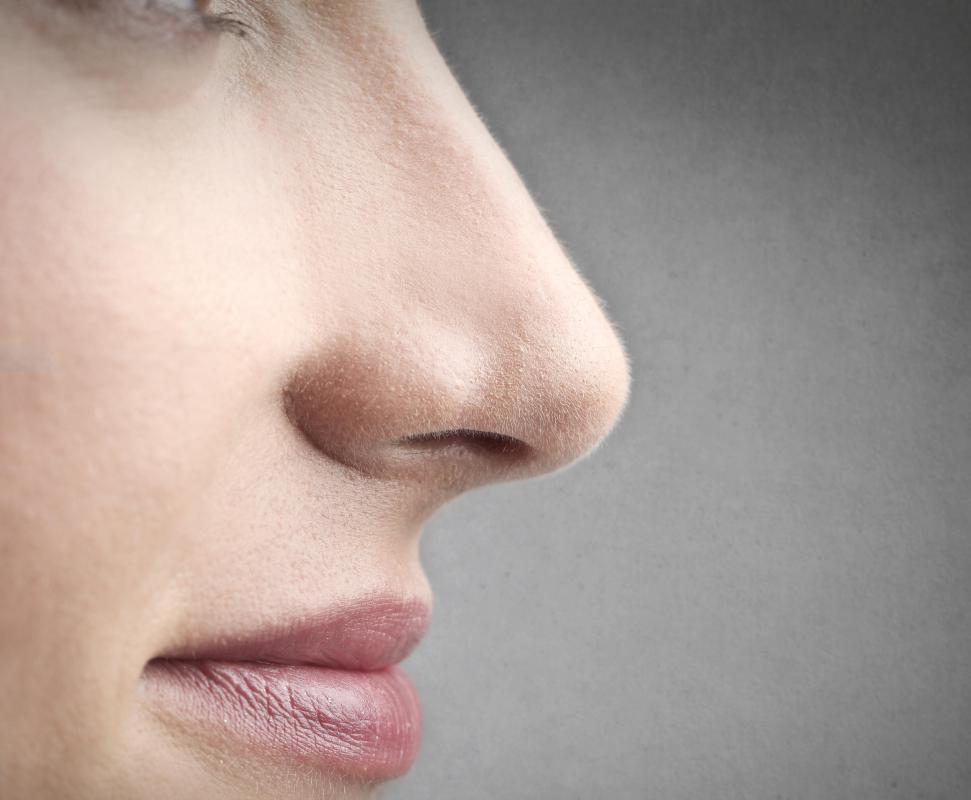At TheHealthBoard, we're committed to delivering accurate, trustworthy information. Our expert-authored content is rigorously fact-checked and sourced from credible authorities. Discover how we uphold the highest standards in providing you with reliable knowledge.
What is the Nasal Mucosa?
The nasal mucosa, also known as the mucous membrane and respiratory mucosa, is the tissue that lines the nasal cavity. The tissue is made up of four layers. The mucous lining is the first layer, which provides a protective lining that catches bacteria in order to prevent infection. The pseudostratified columnar epithelium, the basement membrane, and the lamina propria are the remaining layers, which hold the tissue cells, blood vessels, and glands that produce the protective mucous.
The nasal mucosa is moist tissue that secretes mucous. This mucous lines the nasal cavity in order to catch bacteria and other materials that enter the nose. The nasal cavity is particularly susceptible to infection and other problems because of its exposure to the environment. When people inhale through their nose, they are not only introducing oxygen to the internal body, but they are also introducing any dirt or bacteria in the air they breathe.

The mucous produced by the nasal mucosa is the body's answer to the vulnerability of exposed internal tissue. Other parts of the body with exposed tissue do the same thing. The ears, for example, secrete a thick, waxy mucous that catches bacteria, protecting the inner ear from infection. The mucous produced within the nasal cavity is different and of a thinner consistency than the mucous in the ear.

The first layer within the nasal mucosa, under the mucous lining, is the pseudostratified columnar epithelium. Within the epithelium layer reside many goblet cells, which are described as being flask-shaped. Just underneath the epithelium is the basement membrane, which serves as an anchor for the epithelium cells. The bottom layer of the nasal cavity tissue, under the basement membrane, is the lamina propria, which is filled with blood vessels and seromucosal glands.

Another major function of the nasal mucosa is conditioning the air for entrance into the rest of the respiratory system. Part of this preparation includes trapping bacteria and other foreign particles in the mucous, which is then forced to the back of the throat by cilia. Cilia are small, hair-like fibers that line the nasal cavity walls and protect the tissue from infection. The mucous within the nasal mucosa not only serves to remove bacteria from the air entering the respiratory system, but it also humidifies, or adds moisture, to the air. Another way the nasal cavity lining prepares air to enter the respiratory system is by warming it with the heat radiating from the blood vessels within the lamina propria.

Even with the protective lining of mucous, the nasal mucosa remains quite susceptible to infection and inflammation. When this tissue is infected, it is called rhinitis. Rhinitis is a general term that describes any condition that results in infected and irritated nasal cavity lining. The most common cause of rhinitis is the common cold, but it can also be the result of allergies or other infections. An infected mucous membrane will produce discharge, congestion, and swelling.
AS FEATURED ON:
AS FEATURED ON:




















Discussion Comments
ZipLine-- That's right. We are learning about this in health class and apparently, nasal mucosa also regulates the temperature and humidity of the air we breathe. It warms air as it passes through and also adds some moisture to it. Our lungs dislike cold and dry air. So we basically have our own little air conditioner in our nose to make sure the air is suitable for our lungs.
It's actually quite amazing how a small membrane and the mucus it produces serves so many different purposes.
Most people are familiar with nasal mucosa and how it helps keep out infections but few people know that we also require nasal mucus for our sense of smell.
We are able to smell because our nasal membrane has nerves and receptors. Mucus is the carrier in which the tiny particles reach these receptors in the nasal membrane, which then communicate with the brain to tell us what we are smelling.
This is why when we have a stuffy nose or other issues with our nasal membrane or mucus, we are not able to smell as well. Since our sense of smell plays a role in taste, it reduces our ability to taste as well.
Ah, so this is why we get a runny and also stuffy nose when we are sick. I had never understood why this happens but it's apparently the reaction of nasal mucosa to bacteria. Since we have more bacteria in our system when we are ill, nasal mucosa is trying to trap it and get rid of it by producing more mucus. It's actually a good thing t get a runny nose when we're sick!
Post your comments